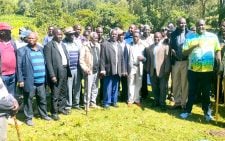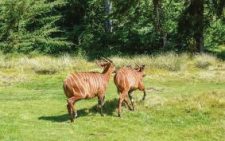Kenya is not ripe for consumptive utilisation of its wildlife resource

Kenya is on the verge of reintroducing the controversial consumptive utilisation of wildlife law, which flopped in the 1970s following a sharp decrease in wildlife population.
On June 25, the Ministry of Tourism and Wildlife concluded the public participation on the Wildlife Conservation and Management (Amendment) Bill, 2023, seeking to amend the existing Wildlife Conservation and Management Act (Act No. 47 of 2013).
Though the amendment aims at streamlining wildlife management targeted at empowering the communities and increasing the revenue, one component is the consumptive utilisation of wildlife.
This refers to the use of wildlife resources where the animal is killed or removed from its habitat, often for purposes like food, hunting, or trade.
This is in contrast to non-consumptive uses like ecotourism, where wildlife is observed or engaged without being harmed.
Fifty years after it flopped, the government is trying to push it back on but its implementation, as captured by the Report of the Task Force on Consumptive Wildlife Utilisation in Kenya, is headed for a thunderous failure and risks Kenya’s heritage.
Consumptive Wildlife Utilisation (CWU) was first articulated in Kenya as a policy in Sessional Paper No. 3 of 1975 entitled Statement on The Future of Wildlife Management Policy in Kenya, to Allow Local Communities to Participate and Earn Benefits Directly from Wildlife.
Before this policy, the cropping of game animals from the wild had been piloted several times.
Previous attempts
In 1961, the cropping of zebra and wildebeest was piloted in Narok District according to a 1967 Food and Agriculture Organisation (FAO) source. A programme on range management supported by FAO in 1966 continued the 1961 cropping efforts of maximising returns from plains game while maintaining the ecological integrity (FAO, 1974).
Between 1975 and 1977, FAO and the Kenya government continued this practice under the Kenya Wildlife Management Project in Kajiado District (FAO, 1980).
The 1975 policy emphasised integrating land-use planning and management with other sectors to make wildlife keeping compete with other land uses.
It envisaged additional space beyond designated protected areas into private and community lands to accommodate wildlife and reap benefits through consumptive uses such as hunting, cropping for meat and trophies, game ranching, live animal capture for restocking or export and adding value to animal products or to non-CWU such as tourism.
The policy prescribed a plurality of means and reasons for conserving wildlife in as many areas as possible as the best guarantee for securing the future of wildlife.
Chapter 5 of the Sessional Paper deals exhaustively with consumptive utilisation of wildlife.
The Wildlife (Conservation and Management) Act of 1976 subsequently established the legal provisions for the new policies and combined the former Game Department and Kenya National Parks as a single agency—the Wildlife Conservation and Management Department (WCMD)—to manage wildlife.
Contrary to expectations, the 1975 policy paper failed to deliver benefits to people outside corporate nature-based tourism and to stem conflicts between people and wildlife, even after Parliament adopted it.
This failure was partly because the Wildlife (Conservation and Management) Act of 1976 did not adequately reflect the intent of the 1975 policy paper or provide strong conditions for its enforcement.
Furthermore, the implementing agency, the Wildlife Conservation and Management Department, was insufficiently funded and thus unable to carry out its conservation mandate.
Consequently, poaching escalated rapidly during the late 1970s, prompting the government to ban hunting in 1977 and, later, trade in trophies (1978) in the interests of giving the larger mammals time to recover.
Though the bans were received positively internationally, the result was that they reduced the incentive to conserve wildlife nationally.
Other policy failures included the continued inability of government agencies to integrate, harmonise and enforce land-use policies and legislation intended to conserve wildlife and other natural resources.
The first steps to rectify the failures in the implementation of the 1975 policy paper included amending the Wildlife Act of 1976 and replacing WCMD with the Kenya Wildlife Service (KWS) in 1990.
KWS formulated a policy framework, KWS Policy framework, and a five-year development programme, commonly referred to as the ‘Zebra Book’.
Financial incentives
As embodied in the policy framework, KWS embarked on a “new concept” of sustainable, participatory wildlife conservation that would supersede past restrictions, allowing landowners to receive benefits from keeping wildlife on their property.
The new KWS policy framework aimed at providing adequate financial incentives to land owners by directly allowing them to use the animals on their lands.
However, the policy did not allow the automatic sale of trophies. Wildlife could be culled or cropped, and the meat and by-products, excluding trophies, sold locally.
To implement this policy, KWS in 1990 started a pilot wildlife cropping trial programme in six regions: Kajiado, Laikipia, Lamu, Machakos, Narok and Samburu.
Though these trials enhanced benefits to landowners, they were discontinued in 2004 after an evaluation report concluded that it was premature for KWS to implement a policy that was not fully backed by legal provisions.
KWS also lacked institutional capacity to implement such a complex programme and lacks the same today.
Other reasons included ineffective controls, unsustainability and a combination of biological, economic and social factors.
Following a time lapse of 28 years, the Wildlife Conservation and Management Act (WCMA 2013) was enacted to replace the Wildlife Act, 1976 and the Wildlife Amendment Act, 1989.
The WCMA 2013 allows for both consumptive and non-consumptive wildlife uses, which have not yet been fully operationalised.
Other legislations that also provide for sustainable wildlife use are Article 69 (1) (a) (d) and (h) of the Constitution of Kenya 2010, the National Wildlife Strategy 2030, Kenya’s Vision 2030 development blueprint, and several international wildlife conventions, treaties and protocols that Kenya is a party to.
It is against this background that in April 2018, the Cabinet Secretary of the Ministry of Tourism and Wildlife established a task force to assess and advise on the modalities of implementing the provisions of WCMA 2013.
Peter Muigai, our Greater Mara landscape coordinator, points out that CUW should not be localised in one area; it should be an integrated approach, knowing the exit population of wildlife per species.
He stresses that in the past, CUW was allowed, but it did not go far because of governance issues.
“Our population is decreasing, and there is data showing our wildlife has decreased by about 65 per cent over time and allowing this might worsen the situation,” he said.
He added that because of the porous nature of the country’s system, consumptive utilisation of wildlife should be shelved until proper laws and policies are developed.
“In Maasai culture, it is taboo to eat wildlife because we are blessed with livestock. Wildlife is important because tourists will continue to flood our parks compared to the slaughter for bush meat or for their trophies,” said Mathew Letura Member of Mara Siana Conservancy in Narok County.
On her part, Anne Kaseiye supports consumptive utilisation of wildlife, only for domestic consumption, not for commercial purposes.
“We support the initiative to allow Kenyans to rear wildlife, especially small wildlife like dik dik, antelope, hare and birds for consumption at the homestead level. Allowing people to sell might open poaching, among other wildlife crimes,” she said.













